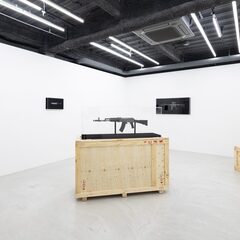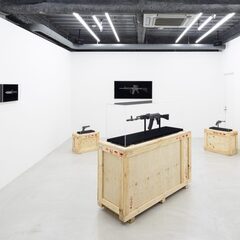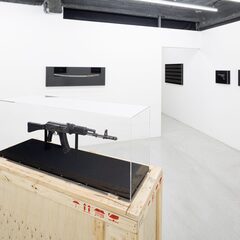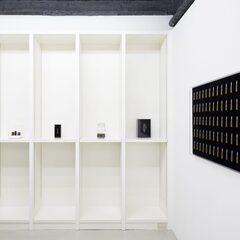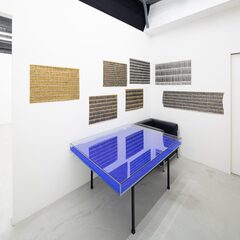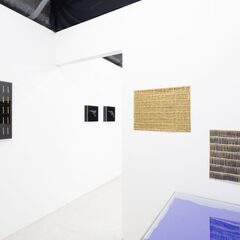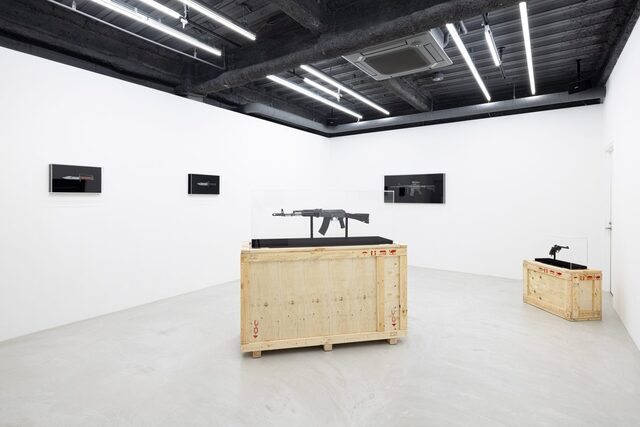
Main Gallery
I, Pencil
Manabu Hasegawa
2024.3.22 Fri - 2024.4.20 Sat
TEZUKAYAMA GALLERY is pleased to announce the solo exhibition “I, Pencil” by Manabu Hasegawa, which will be held from March 22nd (Friday) to April 20th (Saturday).
Manabu Hasegawa was born in Tokyo in 1973 and graduated from the Department of Printmaking, Faculty of Fine Arts at Tame Art University’s Department of Printmaking in 2000. He continues to work in Tokyo. His works involve a technique called “frottage,” in which paper is placed on uneven objects and rubbed with a pencil to trace their contours, creating a duality between two-dimensional and three-dimensional forms.
From his childhood encounter with disabled veterans under the underpass of Ueno, Hasegawa began to question “why such a tragic war occurred” from the time he became conscious. The history of past wars and ongoing conflicts in distant countries appeared to the young Hasegawa as something imbued with a vague but palpable fear of death, leaving an indelible mark in his mind as an object that could never be ignored or silenced.
The current production using frottage originated from the assignments Hasegawa undertook during his university days. It evolved from the nostalgia inherent in the materials of paper and pencil, the comforting feeling of being able to erase what is written, and the gentle connection to memories that arises from the pleasant vibrations and feel of writing transmitted by the pencil. For Hasegawa, these reasons have made paper and pencil a vital material and technique.
In the past, Hasegawa also created frottage works of 500 skulls and 1000 statues of Christ repeatedly could be seen as training. From that experience, Hasegawa’s works moved beyond merely the visual language of original replicas, gradually transitioning towards expressions aimed at pursuing the contours of the “truth” that are not immediately visible.
Hasegawa recounts that initially, the evolution of his current style stemmed from the affinity he found between the rigid, cold texture of guns and the leaden color of pencils. However, while handling weapons and military equipment, symbols that can be seen as bringing death, as the main themes of his works may have been unconscious, it may also have been a reevaluation and confrontation with the underlying issues of war-related questions and fundamental fears of death that he has harbored since childhood. In this regard, there may have been a certain inevitability in returning to and confronting these latent problems.
In this exhibition, which marks his return after approximately nine years, Hasegawa will present new pieces inspired by firearms, grenades, knives, swords, and bullets, all of which are officially adopted by various armies around the world, as well as drawing works inspired by the iconography of Buddhist statues and prints, which are said to have originated in the late Heian period.
The title of the exhibition, “I, Pencil,” is taken from the essay of Leonard E. Read (1898-1983) titled “I, Pencil.” The original text of this essay, written in the form of personification, constructs a narrative tone from the perspective of a pencil. Within the essay, there is a discussion from a higher perspective about the “whirlwind of unconscious connections” among the remarkably numerous individuals involved in the background of the production of a single pencil.
After experiencing a global pandemic that shook traditional lifestyles and values, and as we enter the post-COVID era, along with the onset of military aggression by Russia and the subsequent reemergence of the Palestinian issue, the international situation remains unstable with no sign of resolution. Amid various issues manifesting in today’s world, Hasegawa imagines the sight of humans being ensnared in the unconscious (or subconscious) whirlpool, unable to resist the inexorable currents. As if in prayer, he lets his pencil run, contemplating this helpless entanglement.
[Artist Statement]
The scent of wood and graphite with each sharpening.
The smooth coating felt on the fingertips.
The bitterness when biting the shaft.
The sound of paper rubbing and the conveyed vibration.
The dull color of drawn lines.
The reassurance of erasability with an eraser.
The gradual diminishment in size.
The pencil is connected to the heart.
